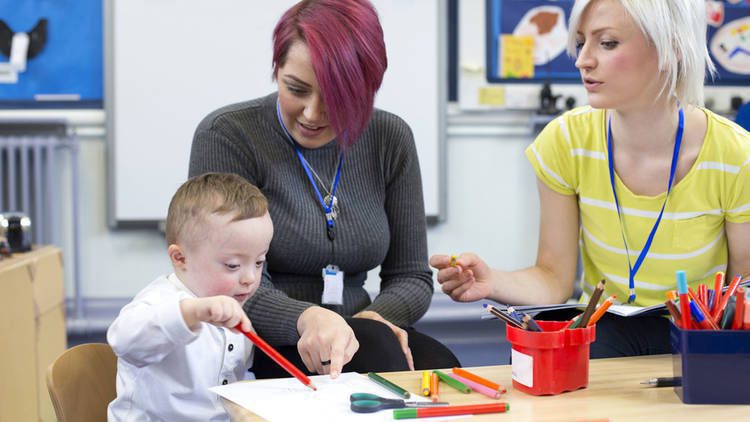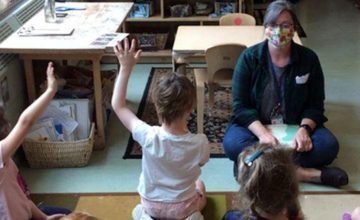The Early Head Start-Child Care Partnerships grew from a recognition that our current child care system—in which 6 million infants and toddlers find themselves daily—just isn’t giving young children the quality support they need to get their early learning on track.
The majority of child care for infants and toddlers is of poor to mediocre quality. Babies who start life already at risk, in families who live below the poverty line, in particular do not get the support they need to overcome the obstacles to staying on course developmentally. (Those living in poverty are one quarter of all infants and toddlers in the United States, by the way.) While these children would benefit most from high-quality child care, they often are the least likely to receive it.
There are a happy few who are assured of a certain level of quality as soon as they enroll. They are the 100,000 or so infants and toddlers who are in Early Head Start (EHS). All EHS programs must adhere to the Head Start Program Performance Standards (HSPPS). Standards make a difference in a child’s early development and learning. The EHS evaluation, a rigorous, randomized control trial study mandated by Congress, found that children had better outcomes in programs that implemented the HSPPS thoroughly.
This is not to say that there are not child care programs that are of good quality. Some may even receive funding through the main federal child care funding stream, the Child Care and Development Block Grant (CCDBG). But there is no national floor for quality for CCDBG or any type of child care. States have the flexibility to set standards where they wish and monitor as they like.
Add to the mix the misguided attitude inherent in the idea of child care as purely a work support, not as an early learning setting. Quality—in the sense of care good enough to put or keep infants and toddlers on the right developmental track—has no purchase if the frame of reference is just a place for children to hang out while parents work.
Let’s put that notion to rest once and for all. Early brain development is shaped by early experiences and the relationships with trusted adults who guide those experiences. Babies’ brains don’t know if adults have designated a program “just child care.” But they do know if they don’t get much interaction with the adult who cares for them because she has to tend to five other infants or toddlers. They also know when an adult has time to direct a lot of talking—or “serve and return”—their way, because he is responsible for fewer children. In short, babies’ brains absorb negative experiences as well as positive ones, regardless of the policy goals that shaped the setting in which these experiences occur.
What’s the quality gap? As our fact sheet on Building Partnerships Between Early Head Start Grantees and Child Care Providers points out, EHS standards are generally higher than the floor provided by state regulations. Consider standards for centers in key areas.
- Ratios: EHS requires a ratio of 1 staff person for every 4 infants and toddlers. While 35 states meet this standard for infants, only 16 states meet it for toddlers.
- Group size: EHS allows only 8 children in a group. 40% of all states meet or exceed this standard for infants, but very few do so for toddlers.
- Teacher qualifications: EHS teachers must have a CDA credential or above, or complete one within a year of starting service and must be trained in early childhood development with a focus on infant-toddler development. Only 10 states require lead teachers in child care centers to have a CDA credential or higher.
This gap will be a wide one to bridge for some programs. But they will have yet another indicator of differences between subsidized low-income child care programs and EHS to help them, that is, expenditures per child. The average child care reimbursement for an infant and toddler is $6,000. The average EHS expenditure per child is roughly twice that. This difference is the key to why many providers can’t afford to provide higher quality and why parents on subsidies often don’t have the means to seek it. Where higher quality care exists, it is usually in response to the demands of more affluent parents. Given that reimbursement levels in the vast majority of states don’t approach even the benchmark level of 75th percentile of the market rate, it is unlikely that child care subsidies greatly enhance access for the lowest income families to high-quality care, even if they can find it. With the buying power of CCDBG funds steadily eroding while moms continue to enter the labor force, states face a choice of spending their child care dollars trying to maintain enrollment or striving for a higher level of quality.
The EHS-Child Care Partnerships would close these quality gaps, including the cost, by layering EHS funds on child care subsidies where possible. This practice will yield a high enough expenditure per child to implement quality enhancements such as allowing staff to have fewer children in their care and increasing compensation for credentialed employees. The hope is that quality will be infused in child care beyond the children who will now technically be in Early Head Start.
The larger question for the long term is how to ensure that the quality floor for any type of early childhood program is high enough to give the most disadvantaged children the developmental support they need so they won’t face the achievement gap that opens up when they are burbling their first words. As with all actions aimed at supporting positive early development, the key is intentionality. If we want to promote better outcomes for children, we make sure there is a floor of quality high enough to achieve that intent—and the financial resources to reach it.
The Partnerships are important on many levels, not least of which is their explicit acknowledgment that the quality gap exists. They will provide not just a mechanism for improving quality, but it is hoped, a mind set that quality is a necessity regardless of program labels. But to realize this goal for all infants and toddlers in child care will be a huge undertaking, both in terms of hard work in the early childhood field and of investments. It requires a bigger conversation among policymakers at all levels about just how intentional we are going to be in putting our youngest children on the path to school readiness. It is to be hoped that the Partnerships will help spark that conversation.





